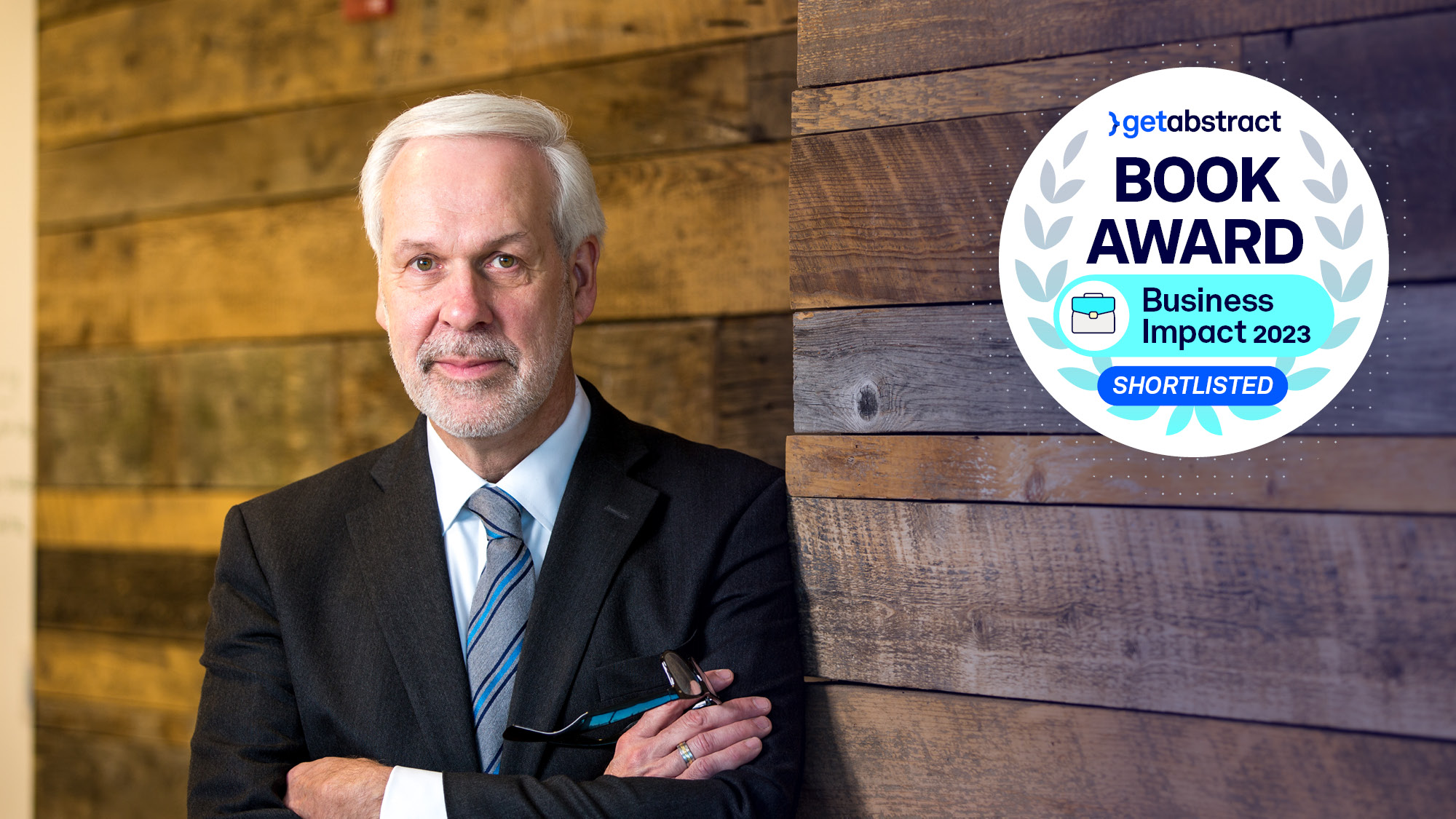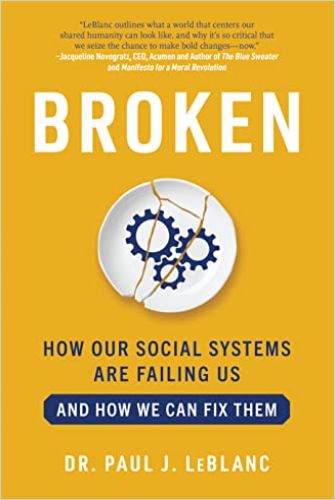“It’s Crucial to Identify and Prioritize the Human Interactions That Are Most Impactful.”

As organizations scale, they start to develop a logic of their own. This leaves the people they serve feeling dehumanized, argues Southern New Hampshire University President Paul LeBlanc in Broken: How Our Social Systems Are Failing Us and How We Can Fix Them. In this wide-ranging conversation, we discuss how organizations can scale humanely – and what leaders and everybody else can do to show others that they matter.
Paul, could you tell us a little bit about Southern New Hampshire University (SNHU) and the people it serves?
SNHU primarily caters to individuals who juggle a full-time job or family responsibilities and are looking to further their education to unlock new opportunities. With our tailored online learning approach, our students can fit their studies around their busy lives. Post-pandemic, we’ve seen a rise in enrollment of traditional-aged students (17-24) – digital natives who find that the online learning format better suits their lifestyle. Mental health challenges may also lead learners to opt for online learning.

Under your leadership, SNHU has grown from 2,800 students to more than 180,000 learners – Can you share something about the process? How were you able to maintain a “small college feel” within an institution of that size?
At the heart of our approach is ensuring that every student feels that there’s someone deeply invested in their individual journey. Academic advisors play a key role here. These advisors are more like life coaches who stay with the students throughout their educational journey. They become intimately acquainted with a student’s life, from knowing about their families to understanding their academic challenges. Not only do they offer academic guidance, but they provide emotional support and a personal connection so our online students never feel isolated. A testament to this approach is the bond students form with their advisors, often culminating in emotional face-to-face reunions at graduation. It’s this individual attention that replicates the close-knit environment of a small college.
In your book, Broken, you highlight the essential role of human relationships in transformative learning. How do you free up human resources at your university so your staff can spend so much time with students (while keeping tuition at a reasonable level)?
While interviewing innovators at different institutions for my book, I found one common theme: They all focus on human connection where it matters most and leverage technology to scale all other aspects of their work. For instance, many advisors at our institution used to spend a disproportionate amount of time on bureaucratic processes, which could be automated, rather than fostering deep relationships with students.
At the heart of our approach is ensuring that every student feels that there’s someone deeply invested in their individual journey.
Paul LeBlanc
Similarly, in fields like healthcare and K-12 education, professionals spend an excessive amount of time putting in data and attending to other administrative tasks rather than focusing on the human aspects of their work. Many modern systems of care, especially in the US, have been inclined to prioritize technology and efficiency over human connection, which often leads to inefficient outcomes despite high expenditures. We need to fundamentally rethink how we approach large-scale systems of care, prioritizing human interaction where it’s most impactful and using technology as an enabler, not a replacement.
How can large organizations become more humane – in terms of making people feel that they matter? How do you make institutions more people-centric?
It’s crucial to identify and prioritize the human interactions that are most impactful. For example, in substance abuse treatment, though insurance companies often favor clinical interventions due to their measurable outcomes and monetary incentives, the actual transformative work occurs in counseling sessions. It’s these human relationships – the counselor who gets to know you well and the peer group that understands the complexities of your situation – that genuinely make a difference. We need to discern where the most important human relationships lie and then scale or automate all other processes.
Of course, this also requires setting the right financial incentives…
In many sectors, like health care, the trend is to minimize patient time and maximize clinical interventions – things like laboratory testing, X-rays, MRIs, etc. – because they’re financially lucrative. But what doctors will tell you is that they don’t get enough time with patients, and what patients will tell you is that all they want from their caregivers is to be seen and heard. Caretakers can’t focus on the human relationship if they are looking down at a screen, typing in data, and then rush to the next patient.
We need to discern where the most important human relationships lie and then scale or automate all other processes.
Paul LeBlanc
Your book includes an entire chapter on the concept of “mattering.” Could you briefly tell us what you mean by the term and how mattering can be an agent of change?
Mattering is the bedrock principle underlying my entire book. Drawing from sociologist Greg Elliott’s research, mattering represents the deep-seated human need to feel seen. But beyond just recognition, people want to be surrounded by people who invest in their growth and potential. And third, people need a sense of agency – the feeling that they can influence and shape their environment. All three aspects are critical for transformation.
Do you have practical advice for leaders on how to show people that they matter?
People want to see that you invest in them. Are there ways in which you’re developing the people you lead? The number one reason people, particularly young people, are leaving their employers post-pandemic is not money but a lack of opportunity to grow and develop – a feeling of not being invested in. As for agency, people want to feel that they have an impact in shaping their organization. As a leader, you will want to ask yourself, ‘Do I really listen to my employees’ or students’ input?’ If people never see any of their suggestions implemented, they will come to believe that they don’t matter.
In the last chapter of your book, you are using the word “love” – not a commonly used term when talking about leadership…
Making someone feel seen and investing time in them is a kind of love. And that’s what transformative, innovative companies increasingly do. It’s also why we at SNHU are so successful at imparting these feelings to people at scale. If you ask students at some of America’s most prestigious universities, ‘Do you feel like your school knows you?’ they will likely say, ‘Absolutely not.’ Do they feel like they’re loved? The answer would be no.
People want to see that you invest in them.
Paul LeBlanc
To have managers spend more time with people, wouldn’t that necessitate a change in incentive structures – a change in how managers are evaluated and rewarded?
You’re putting your finger on one of the key points of the book. You will have to re-engineer the reward and recognition structure of whatever kind of organization you lead. Let me stay with my example of the prestigious university. If I want to get tenured as a faculty member, I don’t get any points for being a great teacher or for building personal relationships with students to help them develop. But I will get evaluated by the number of publications I put out. Universities may say that their most important asset is their students, yet their reward structure does not reflect that.
You sound quite optimistic when it comes to employing technology, including AI, in freeing up people to spend more time connecting with others. How can we leverage technology to help restore human relationships?
I don’t want AI to replace critical human relationships. I want AI to alleviate time spent on mundane tasks, such as low-level bureaucratic work. For instance, faculty members don’t enjoy grading papers; automating this could give them more time for meaningful student interactions. What if teachers could spend that time interacting with students?
You will have to re-engineer the reward and recognition structure of whatever kind of organization you lead.
Paul LeBlanc
AI is set to displace knowledge work. AI algorithms already surpass humans at many different types of knowledge work, so the important question to ask is: What uniquely human tasks do we excel at? There’s an abundance of essential human roles to be filled, from teachers to social workers and counselors. AI is not going to fix our broken criminal justice system or address the mental health crisis. While AI can offer insights, the truly transformative work comes from humans who can sit down with somebody, make them feel loved and understood, and help them lift their aspirations and hopes. In contemporary society, however, we value and give status to knowledge work. We don’t like to pay teachers. We don’t like to pay social workers. We don’t like to pay mental health workers. This has to change.
Are you optimistic that such a broad shift in what we value and reward as a society will happen?
We currently find ourselves in what some people have called ‘in-between times’. If you look at other paradigm-shifting technologies in history, such as the invention of electricity or the Industrial Revolution, the world was fundamentally changed. We are now in a reinvention phase where things we used to value become less important and other things we used to pay less attention to become more valuable. Now that AI can do so much of our knowledge work for us, I am hopeful that we will return to value human work and human relationships more.
AI algorithms already surpass humans at many different types of knowledge work, so the important question to ask is: What uniquely human tasks do we excel at?
Paul LeBlanc
What is a first step each of us, regardless of position, can take today to signal that we matter or that somebody else matters?
The research is unequivocal when it comes to fostering healthy human relationships. Establishing strong human connections requires two things. First, you have to build trust. The only way you can build trust is through your own vulnerability, through your own sharing. By being vulnerable, you signal to the other person that they can trust you to do the same. Second, you need to invest time in your relationships. You cannot short-change time. Real relationships take time. A doctor who rushes in and out within two minutes won’t be able to impart the feeling to their patients that they matter to them – while a doctor who takes the time to ask how you are doing and what’s going on in your life will. Similarly, a leader who never takes the time to sit together with their people won’t be effective. We are entering into a new stage of leadership, which is going to be about relationships. Can I finish with a quote?
Go ahead…
At West Point, America’s premier military academy, they remind aspiring leaders: ‘Your soldiers won’t care what you know until they know that you care.’ You can use this quote in any organization. You can be as smart as you like. You can be incredibly accomplished in so many ways. But the people you lead won’t care about those things until they know that you care about them.







